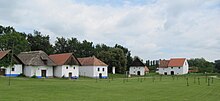Moravian Slovakia


Moravian Slovakia, also called Slovácko (Czech: Slovácko, older Moravské Slovensko) is a cultural region in the southeastern part of the Czech Republic. It lies in the historical region of Moravia, on the border with Slovakia (the Slovak region of Záhorie) and Austria. It is known for its characteristic folklore, music, wine, costumes and traditions. The area forms part of both the Zlín and South Moravian administrative regions.
Its main centre is the town of Uherské Hradiště which is located on the Morava River. Other important towns include Uherský Brod, Břeclav, Hodonín, Strážnice and Kyjov. In the 9th century the region of Moravian Slovakia was the centre of the Great Moravian empire.
Subregions
[edit]Moravian Slovakia is divided into six subregions: Dolňácko, Horňácko, Podluží, Moravské Kopanice, Hanácké Slovácko and Luhačovické zálesí.[1]
Economy
[edit]Moravian Slovakia is noted for its viticulture.
Language
[edit]Natives of this region speak the Eastern Moravian dialects of the Czech language, which are transitional dialects between Czech and Slovak. Due to these cultural and linguistic links to Slovakia, many ethnographers until the 20th century used to consider Moravian Slovaks as a people which politically belonged to Moravia and the Bohemian Crown but ethnographically and culturally to the Slovak ethnic group. Historically, there were also significant numbers of German speakers who also influenced local speech.
Sport
[edit]Since 2004, the football club from Uherské Hradiště is named 1. FC Slovácko and is rare example of a Czech club holding the name of its home region and not of its home city or town.
Notable people
[edit]- Tomáš Garrigue Masaryk, philosopher, president of Czechoslovakia
- Jan Černý, president of Moravia, PM of Czechoslovakia
- John Amos Comenius, philosopher, founder of modern education
- František Peřina, general, RAF ace
- Václav Nedomanský, Hall of Fame ice hockey player
References
[edit]- ^ "Tip for a Trip: Moravian Slovakia – Where Time Froze Still". foreigners.cz. Foreigners.cz. 2020-07-14. Retrieved 2020-09-14.
Further reading
[edit]- Johnston, Jesse A. (2010). "The Cimbál (Cimbalom) and Folk Music in Moravian Slovakia and Valachia". Journal of the American Musical Instrument Society. 36: 78–117. hdl:2027.42/87955.
- Bogatyrev, Petr, Richard G. Crum (1973).The functions of folk costume in Moravian Slovakia. American Anthropologist, Volume 75, Issue 6, page 1896.[1]
- Bogatyrev, Petr, (1971).The functions of folk costume in Moravian Slovakia. Mouton.
External links
[edit]- Official tourist portal
- The Museum of Moravian Slovakia
- Moravian Slovakia at the South Moravian Region website
Text is available under the CC BY-SA 4.0 license; additional terms may apply.
Images, videos and audio are available under their respective licenses.
